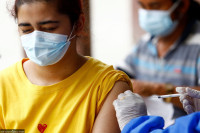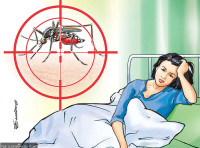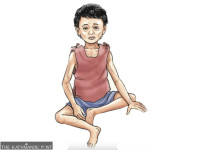Health
When bugs get stronger than drugs
In December 2009, a Swedish national of Indian origin fell ill with an antibiotic-resistant infection that he acquired in India.
Dibesh Karmacharya & Manisha Bista
In December 2009, a Swedish national of Indian origin fell ill with an antibiotic-resistant infection that he acquired in India. The infection was identified as a bacteria strain that is resistant to the widely used antibiotic—carbapenem, bearing the newly mutated New Delhi Metallo-beta-lactamase-1 (NDM-1) gene. In May 2010, another similar infection was reported in Coventry in the United Kingdom. The patient was a man of Indian origin who had visited India 18 months prior, where he had undergone dialysis. At the time, a warning was issued on the infected patient’s use of multiple countries’ healthcare systems leading to the rapid spread of NDM-1 mutated bacteria with potentially serious consequences to global public health.
Infectious diseases are responsible for 26 percent of human deaths worldwide. And as travel gets more convenient, the spread of infectious diseases—including Multiple Drug Resistance (MDR) bacteria—is becoming more and more likely. Drug resistance was first discovered 10 years after the first use of antibiotics in 1940s. Since then, the use of antimicrobials has been increasing steadily around the world saving millions of lives. Newly emerging superbugs, however, produce enzymes that make them resistant to the drugs being administered. AMR is a natural evolutionary response by bacteria to cope with antibiotic onslaught, where their genes are modified to fight against the medication. Often these mutated genes like NDM-1 can transfer among bacteria groups, priming them to spread like wildfire when conditions are ripe. AMR infections are usually hospital acquired infections. They can also be transmitted directly from person to person or through contaminated food and water. With the emergence of Anti-Microbial Resistance (AMR) pathogens, control of infectious diseases has become an emerging and growing challenge, and mutated bacteria like E. Coli, S. Aureus and K. Pneumonia that are resistant to antibiotics have been reported in Nepal as well.
Implications for Nepal
Although superbugs like NDM-1 has not been detected in the country, Nepal remains highly susceptible to the possibility of an outbreak. In Nepal, over-the counter availability and use of antibiotics without prescriptions is common. According to the 2010 WHO report, more than 60 percent of patients in the public sector and 70 percent in the private sector are not treated according to clinical guidelines in developing countries. A 2011 report produced by Department of Drug Administration (DDA) states that the misuse of antibiotics by health professionals is rampant in Nepal which can contribute towards the creation and spread of antibiotic resistance bacteria.
Such haphazard use of antibiotics, including its use in livestock and poultry production, has left the country extremely vulnerable to the emergence of AMR. These AMR bacteria then can be transmitted from animals to humans through close contacts with animals and their products, including contaminating surrounding environment. In Nepal, a report published by the Central Veterinary Laboratory (CVL) in 2011 showed the presence of AMR bacteria in poultry meat. Animals and their products are also imported from different countries into Nepal which could result in trans-boundary spread of AMR bacteria.
Further, even if superbugs have not been reported in the country, hospitals in India have been found to carry this infection. Many Nepalis visit India for treatments and this could be a possible source of NDM-1 infection into Nepal. Superbugs like NDM-1 can be transmitted through faecal-oral route, inadequate availability of safe drinking water and latrines, affecting poor and marginalised community more than affluent ones. And with the access of health care in the country still very limited, majority of people in Nepal cannot afford proper medical care, often relying on pharmacies and non-medical personnel for medical advice, which might lead to inappropriate use of antibiotics and AMR emergence.
Public health implications
Detecting and preventing the spread of AMR bacteria is often challenging in developing countries like Nepal due to poor diagnostic and surveillance capacities. For instance, respiratory infection is one of the major causes of death in Nepal, particularly in children under five. Lower respiratory tract infections caused by several species of pathogens are also a major health challenge in Nepal. Children, elderly and immuno-compromised population are highly susceptible to the infections. These prevalent and clinically significant bacteria morphing into AMR can be a nightmare scenario for public health management.
With that in mind, the Ministry of Health and Population (MoHP) has developed antibiotic treatment guidelines under the National Drug Policy to fulfil objectives of the Drug Act and the National Health Policy. However, it has not fully addressed the issue of over the counter availability of antimicrobial in Nepal. AMR infections are often hospital or clinical based in origin. Without proper and specific guidelines to deal with AMR, healthcare workers and general public are vulnerable to the infection. Limited options in available antibiotics to treat AMR can pose a great challenge in containing the infection once they start spreading into communities.
Economic impact of the disease
Apart from being a major public health concern, drug-resistant bacterial infections can also have an adverse economic impact on the public healthcare system. Once there is an outbreak in hospitals, there needs to be a total shut down and decontamination to eliminate and contain the infection. Besides, the cost of treatment can also be considerably high due to long hospital stay to get rid of the infection.
AMR outbreaks might also adversely affect international trade and tourism restrictions based on sanitary measures and International Health Regulations (IHR). Nepal is vulnerable to significant economic loss if there is any AMR outbreak. Recently detected MDR NDM-1 puts Nepal under global health security threat. It is imperative for Nepal to take necessary initiative for the prevention and control of the infection.
What can be done?
Nepal can learn from other countries facing AMR outbreaks, and develop surveillance and control strategies suitable for the country.
National Antimicrobial Resistance Control Program (NARCP) collaborating public health and animal health should be initiated in the country which will be responsible for surveillance, diagnosis and control of AMR including NDM-1. Effective control strategies like quarantine and decontamination must be adopted and implemented when AMR cases are suspected. Laboratory investigation followed by epidemiological study should also be undertaken to identify the source and probable spread of the agent. Strict sanitary regulations in hospitals and health care facilities are also a need of the hour.
Further, every year large quantities of antimicrobials are used as treatment in people, animals and agriculture. Monitoring of antibiotic use needs to be done for both public and private healthcare outlets as prescribed by guidelines in the Nepal Health Service Act. With the control of unnecessary prescription and sales of antibiotics in mind, the Department of Drug Administration (DDA) should create an effective monitoring and evaluation system to promote judicial use of antimicrobials. The antibiotic resistance have been reduced in some countries through the restriction in use of antimicrobials. Alternative-therapies should be explored and assessed; government should encourage research on alternative therapies to innovate remedies that can substitute the use of antibiotics. Vaccinations remain the best preventive measure to avoid infection in the first place, the absence of infection avoids the need to use antimicrobials and obtain low drug adherence.
The Government of Nepal has been conducting the AMR surveillance since 1990. Twenty health institutions and laboratories are part of the surveillance. Given the present danger of the spread of AMR, this active surveillance should be extended to all hospitals across the country.
And while it is our responsibility to inform national and international community about the AMR outbreak in Nepal, the information should not instigate mass hysteria. As part of our commitment to “right to information” act, news on detection of AMR should be made public. MoHP and its information centre in coordination with the Ministry of Information and Communications (MoIC) should plan a press release to inform people about presence of superbug in hospitals, protecting personal and confidential information. Part of the information dissemination should be known preventive measures that will safeguard public from this infection.
The emergence of AMR is no longer just a theory for medical journals; particularly in developing countries like Nepal, the possibility of an outbreak and mass contamination remain ever present. With that in mind, all concerned stakeholders need to remain vigilant and prepared for the worst. Because even as drugs are crucial to the quality of life and longevity today, when bugs get stronger than drugs, its effects on a country and its health service systems can be devastating.
Bista is a public health expert and a Disease Surveillance Officer. Karmacharya is a geneticist and biomedical expert. Both authors are associated with the Center for Molecular Dynamics Nepal




 12.12°C Kathmandu
12.12°C Kathmandu














